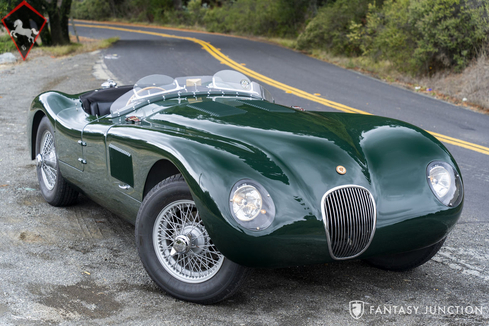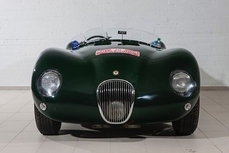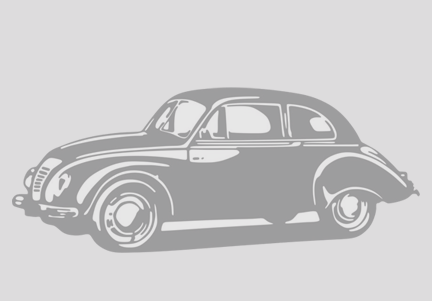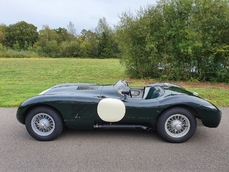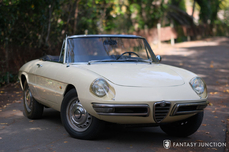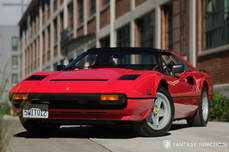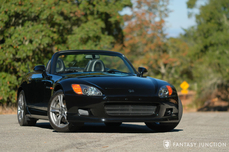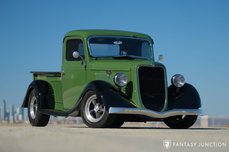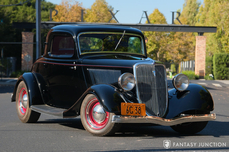Jaguar C-Type 3.4 Liter Inline Six 1954
Allgemeine Beschreibung :
1952 Jaguar C-Type Recreation by Proteus
s/n 672749, Engine no. W5758-8
British Racing Green with Black Interior
Among the most celebrated of sports cars, Jaguar has continually offered innovative designs, exceptional competition cars, and tremendous engineering capacity. The legendary C-Type Jaguar embodies all these traits. Beginning with the Malcolm Sayer body design, the graceful aerodynamic body is itself a work of art. This functional and beautiful design was coupled with the twin cam XK series engine and disc brakes, making C-Types dominant forces in races, winning at Le Mans in 1951 and again in 1953. With a mere 52 examples assembled at the factory, today some of the finest C-Types are selling for eight figures at premium auctions. For the motoring enthusiast who seeks the experience of such a great car, a faithful re-creation, uniting authenticity with upgraded engineering, makes for an enjoyable motorcar with the performance and visual heritage to properly celebrate the original.
This Jaguar C-Type was constructed in the 1980s with careful attention to originality and fabrication, befitting a car of this status. At that time, Proteus, now a premier fabrication house creating some of the best C-Type replicas in the world, had just started their operation. This car was assembled using an original 1950s 3.4 Liter Jaguar engine procured from an XK120 and rebuilt for this application. The 1952 XK120 ID tag was riveted to the firewall at assembly and indicates the engine number, which matches with the number stamped on the head currently in the car. Large SU H8 sand cast carburetors were installed with a handmade aluminum airbox, feeding the twin-cam engine. A Moss gearbox was used for shifting duties much as they were in original Jaguars. Dunlop disc brakes were mounted at all four wheels and correctly painted 16” wire wheels were installed. Proteus assembled all their cars using aluminum coachwork over a specially constructed chassis with attention to original specifications and body design, closely matching the original cars. The hand crafted aluminum body involved 600 hours of fabrication before being mated to the chassis. Period correct details were used throughout the exterior and interior, in order to capture the essence of the original C-Type racing cars and still deliver reliable street performance for enthusiast driving.Today this car presents very nicely, having been regularly serviced and recently tuned and adjusted to ensure proper operation. Originally commissioned by an enthusiast who specified the car be as close to factory original as fiscally possible, the build was carried out and completed with only a few miles put on the car under his ownership. The car was then sold to the second owner and subsequently offered for sale by Fantasy Junction in 2017. The current owner purchased this car from Fantasy Junction that same year adding only minimal miles to it under his ownership. The car is finished in the quintessential British Racing Green, which has been enjoyed and generally preserved over the years, showing only mild evidence of road use in a few areas, and a few scrapes noted at the rear of the car. The odometer indicates fewer than 2,000 miles have accumulated during the restrained life of this C-Type Recreation. The paint is glossy throughout and captures the fluidity of the undulating fender lines much as the original did more than half a century ago. The construction of the alloy body panels is exceptional, with excellent fit and finish, showing only minor areas of use over time - a further testament to the Proteus quality and allegiance to the original. The visual delight continues throughout the exterior of the car with very nice trim, lighting, properly nested side exhaust, clear headlight covers, and correctly painted wire wheels. New tires were fitted in 2019. The interior delivers a handsome combination of racing history and purposeful features. Instruments are neatly clustered behind a beautiful wood-rimmed steering wheel adorned with the Jaguar emblem. The dial faces on the instruments (many of them rare now and hard to find) are in excellent condition with clear glass and finely detailed indications. The fuel gauge needle migrates a bit unpredictably while in motion. The black seats are accurately presented, nested in the race-trimmed cockpit, revealing just a few silver-painted frame tubes, inclusive of the C-Type’s preeminent racing heritage. The cockpit is both purposeful and engaging, inviting one to drive with ambition and intent, as there are little distractions to deter your focus. The aircraft inspiration, low windscreen, and racing heritage, combined with just a hint of elegant material touches deliver a wonderful feel to the interior of the car.Under the hood, the craftsmanship continues to inspire onlookers with visions of vintage Le Mans racing. The engine is prominently featured with dual carburetors, a handmade aluminum airbox, and polished cam covers gleaming against the correctly finished red twin-cam C-Type head. Hardware has been appropriately updated, allowing for improvements where modern technology enhances reliability and safety. These improvements are evident when driving this well-balanced and properly engineered car. The engine fires to life eagerly and settles into a smooth but slightly raspy exhaust and excellent throttle response, offering a symphony of motorsports brilliance with each tap of the throttle. The driving experience is very satisfying, cohesive, and engaging. Even the most comfortable and familiar drivers of vintage sports cars will appreciate the balance and excitement driving in this car. Shifting is smooth and easy with positive feel and good clutch engagement. Pressing harder on the throttle there is no hesitation at highway speeds through all gears as the car pulls strong. Disc brakes deliver good grip, providing ample stopping power, while the live rear axle works surprisingly well in this package, delivering good grip and confidence even in tighter corners. A masterpiece of automotive design and racing excellence, the Jaguar C-Type is a dream only a few can aspire to own. However, with a contemporary recreation of the highest order, fortunate enthusiasts are afforded the opportunity to experience both the history and motoring excellence of these great cars. This stunning C-Type is ready to deliver all the promise of the original design, exceptional engineering, and improved reliability, free from the costly tethers of museum curation and preservation.
https://fantasyjunction.com/inventory/1952-jaguar-c-type-by-proteus/overview
1954 Jaguar C-Type 3.4 Liter Inline Six is listed verkauft on ClassicDigest in Emeryville by Fantasy Junction for Preis nicht verfügbar.
Fakten der Auto
Karosserietyp : Auto Marke : Jaguar Modell : C-Type Ausführung : 3.4 Liter Inline Six Hubraum : 3.4 Modelljahr : 1954 Lage : Emeryville Fahrzeug Anmeldung : Normal
Verkauft
Angaben Zum Verkäufer
Verkauft
People who viewed this Jaguar C-Type also viewed similar Jaguar listed at ClassicDigest
Other cars listed for sale by this dealer
über Jaguar
Ah, die Geschichte von Jaguar, von seinen Anfängen als SS Cars Ltd. bis hin zum Höhepunkt mit dem D-Typ und der Straßenversion des ikonischen E-Typs. An dieser Erzählung haftet etwas zutiefst Britisches, und ich werde sie erzählen, wie es ein britischer Journalist tun würde.Die Anfänge:
Unsere Reise in die Welt von Jaguar beginnt in den 1930er Jahren, als ein Unternehmen namens SS Cars Ltd. auftauchte. Trotz des unglücklichen Zufalls ihrer Initialen, die mit den aufkommenden politischen Spannungen in Europa zusammenfielen, begannen sie, stilvolle und leistungsorientierte Autos herzustellen. Der SS 100, der 1936 eingeführt wurde, war ein Symbol für Eleganz und Geschwindigkeit und legte den Grundstein für das, was Jaguar werden sollte.
Die Geburt von Jaguar:
Als der Schatten des Zweiten Weltkriegs näher rückte, entschied sich SS Cars Ltd. klugerweise, sich von den SS-Initialen zu distanzieren. So wurden sie 1945 offiziell zu Jaguar Cars Ltd., ein Name, der bald für britischen Luxus und Leistung stehen würde.
Die XK-Serie:
Die Nachkriegszeit von Jaguar brachte uns den XK 120, eine wahre Sensation im Jahr 1948. Mit seinem schlanken Design und einem leistungsstarken 3,4-Liter-Sechszylindermotor wurde er zum schnellsten Serienauto der Welt. Der XK 120 war die Blaupause für das, was kommen würde - Jaguars, die Stil mit Geschwindigkeit auf einzigartig britische Weise verbanden.
Die Dominanz des D-Typs:
Dann kam der D-Typ, eine wahre Rennlegende. 1954 eingeführt, gewann er in den 1950er Jahren dreimal Le Mans und zeigte die technische Kompetenz von Jaguar. Mit seiner innovativen Monocoque-Konstruktion und der ikonischen Finne hinten war der D-Typ der Höhepunkt von Jaguars Motorsporterfolgen.
Das Auftauchen des E-Typs:
Aber der wahre Wendepunkt kam 1961 mit der Einführung des E-Typs, oft von Enzo Ferrari als "das schönste Auto, das je gebaut wurde" bezeichnet. Seine lange Motorhaube, die geschwungene Karosserie und ein 3,8-Liter-Motor, der atemberaubende Leistung lieferte, machten ihn sofort zu einem Klassiker. Der E-Typ war nicht nur ein Auto; er war ein Kunstwerk auf Rädern und konnte auf der Straße 150 Meilen pro Stunde erreichen.
Straßen- und Rennsporterfolge:
Die Schönheit des E-Typs wurde durch seine Leistung auf der Rennstrecke unterstrichen. Die leichten E-Typen waren bei verschiedenen Rennveranstaltungen besonders erfolgreich und festigten den Ruf von Jaguar als eine Kraft, mit der man im Motorsport rechnen musste.
Das Zeitalter der Raffinesse:
Je tiefer wir in die Geschichte von Jaguar eintauchen, desto mehr erkennen wir, dass die 1950er und 1960er Jahre ein Zeitalter der Raffinesse und Expansion waren. Neben dem großartigen D-Typ und dem ikonischen Aufstieg des E-Typs führte Jaguar Modelle ein, die seinen Ruf für Luxus und Leistung weiter festigten.
Der MK2:
Ende der 1950er Jahre stellte Jaguar den MK2 vor, eine Sportlimousine, die Eleganz mit Leistung vereinte. Diese elegante viertürige Limousine war sowohl bei Bankräubern als auch bei der Polizei aufgrund ihrer außergewöhnlichen Geschwindigkeit und Handhabung beliebt. Der MK2 war ein Symbol für Jaguars Fähigkeit, Raffinesse mit Leistung zu verbinden und hatte auch eine erfolgreiche Rennkarriere.
Der XJ6:
Springen wir ins Jahr 1968, als Jaguar ein Auto auf den Markt brachte, das Jahrzehnte lang Luxuslimousinen definieren würde - den XJ6. Es war ein Meisterwerk der Ingenieurkunst und des Designs, mit einem sanften Reihensechszylindermotor, unabhängiger Hinterachse und einem geräumigen, wunderschön ausgestatteten Innenraum. Der XJ6 war ein Symbol britischer Eleganz und bot eine so sanfte Fahrt, dass es schien, als würde er förmlich über die Straße gleiten. Er wurde zum Flaggschiffmodell für Jaguar und setzte den Maßstab für Luxuslimousinen und zeigte ein Maß an Raffinesse, das die Konkurrenz staunen ließ.
Die Verschmelzung von Klassik und Moderne:
Während der MK2 und der XJ6 die Evolution der Limousinen von Jaguar repräsentierten, bewahrten sie das Engagement der Marke für Leistung und Luxus. Diese Autos gehörten nicht nur auf die Rennstrecke; sie fühlten sich genauso wohl auf den Prachtstraßen wie auf einer entspannten Fahrt durch die englische Landschaft.
Die Herausforderungen des Wandels:
Dennoch sah sich Jaguar mit dem Eintritt der 1970er Jahre, wie viele britische Automobilhersteller, finanziellen Herausforderungen und Veränderungen in der Eigentümerschaft gegenüber. Die Ära von British Leyland brachte sowohl Chancen als auch Schwierigkeiten mit sich, während die Marke durch verschiedene Fusionen und Übergänge navigierte.
Das Erbe des MK2 und des XJ6, zusammen mit dem D-Typ und dem E-Typ, definiert Jaguar weiterhin als einen Hersteller, der zeitlose Eleganz mit einer Leistungsstärke vereint. Diese klassischen Modelle, ob sie über kurvige Straßen gefahren oder als Sammlerschätze geparkt werden, dienen als Zeugnis für die anhaltende Präsenz von Jaguar in der Welt der automobilen Exzellenz.
Die Jaguar-Geschichte, von ihren Anfängen als SS Cars Ltd. bis zur Schaffung von Automobilikonen wie dem E-Typ, dem MK2 und dem XJ6, ist eine Reise, die das Wesen des britischen Automobilbaus widerspiegelt - eine Mischung aus Luxus, Leistung und Stil, die nach wie vor Enthusiasten und Kenner gleichermaßen fasziniert.
